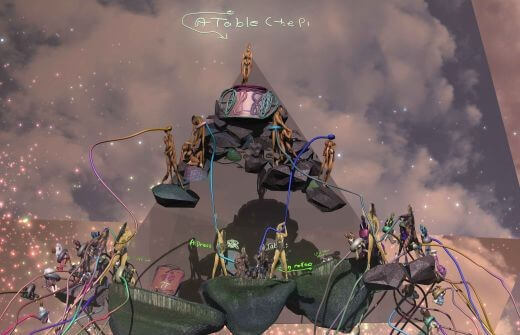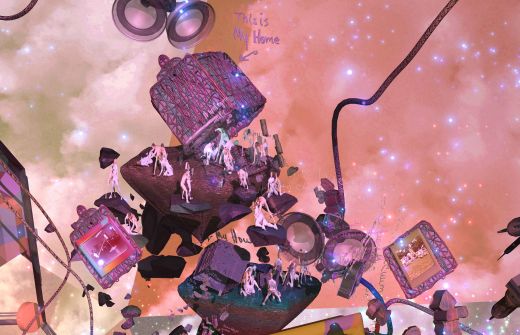- Sense and Nonsensibility: What Miami Teaches, from the Outside Looking in

- Framing a Wall: Math Bass and Lauren Davis Fisher
JACOLBY SATTERWHITE
with Jillian Mayer

Still from Vassalage and Abduction, 2014. C-print, video, and 3D animation. Courtesy Jacolby Satterwhite and OH-WOW Gallery
After discovering his work in 2013 at the Bronx Museum of the Arts, and then again at the New Frontier exhibition at Sundance in 2014, I became aware that I was not viewing the work of an artist dealing with digital versus the physical, but rather with the consideration of a fused universe united by performative elements that incorporate himself and, occasionally, some of his role models.
Satterwhite seems to be the ringleader of the world he makes, which is enriched by icons, objects from QVC, impermanence, form, maternal influences, and popular culture. His work investigates memory and desire, piecing conceptions of both together in a saturated and rendered, geometric plane of existence. Initially a painter who felt the limits of being still and later a video artist who found Adobe After Effects couldn’t perform in a way that matched his concepts, Satterwhite transitioned once again and taught himself Maya, a 3D animation software.
A few months ago, I got to watch him direct Trina in front of a green screen in a studio near the Miami International Airport. I felt like I was on the ground floor of a new Satterwhite universe being created from his very concise and creative blueprints—like I was watching a city being built by a brilliant engineer. He and I discussed all this and his recent and upcoming projects, including the premiere of En Plein Air: Diamond Princess at Pérez Art Museum Miami in April, featuring Trina.

Still from Vassalage
and Abduction, 2014. C-print, video, and 3D animation. Courtesy Jacolby Satterwhite and OH-WOW Gallery
JILLIAN MAYER (MIAMI RAIL): Tell me how you obtained your first computer.
JACOLBY SATTERWHITE: I got my first computer through the Make-a-Wish Foundation when I was eleven years old. I had been diagnosed with cancer, and had to do chemotherapy for two years. The program generously gives terminally ill children these gifts as a gesture to instill hope in them. I was a brat, so when I got the computer, I felt betrayed because it was 1999 and I got a Pentium I computer. They told me I was getting a top-of-the-line computer, and all I could think was, “But Pentium II is already out.” I also got mega-perverted and violent games for it, like Duke Nukem and Diablo. Duke Nukem was especially funny because Duke runs around shooting hookers, strippers, and aliens.
RAIL: You’ve told me you were a gamer growing up. The universes you create in your videos are fully rendered, beautiful 3D landscapes. Would you ever—or have you ever—considered making a playable game? Or, are we watching you as the player?
SATTERWHITE: I’m currently not interested in making a game. What stimulates me as a creative person is being able to control composition and space, rather than allowing the audience to have control over those variables. I’m still resolving some issues I had as a painter within the 3D animation and performance language. But, never say never. Video games have pivoted my aesthetic tremendously. I’ve invested over ten years of intense fourteen-hour days gaming, between my childhood, adolescence, and late teens. The logic of my space is definitely designed by sitting in front of a screen playing Suikoden, The Legend of Zelda: Ocarina of Time, Star Ocean, and Final Fantasy.
RAIL: Can your digital world exist without you?
SATTERWHITE: Of course it can.
RAIL: Your work is very sexual, but in a contained way. Can you tell me about your first sexual experiences online or IRL (or both)?
SATTERWHITE: [Laughs.] I can’t—he’d get arrested if I did…
RAIL: Did your early sexual experiences potentially inform your interest in working with famed porn actor Antonio Biaggi?
SATTERWHITE: Not at all.
RAIL: How did this interest come about, then? How did you initially get involved with Biaggi and with Trina?
SATTERWHITE: Both Antonio and Trina are complicated public mythologies who have difficult bodies of work that seemed useful for me to extrapolate from. Antonio Biaggi represented a certain limitlessness around his performance style that proved to be problematic for certain gay political spheres. I was amused by his blog and by how it became a densely opinionated forum responding to politics, gay rights, sexual politics, nutrition, and animal rights. He even owns a vegan bakery in Florida and contributes to animal care centers. Because the videos in my series Reifying Desire are primarily complicated narratives sitting under the umbrella of simple gestation cycles, I thought featuring a bareback porn star seemed like an appropriate way to end the series.
Trina, however, has a massive discography that lyricizes the pleasures of capitalism, larger-than-life surrealist sex, sexual control, female empowerment, and opulence. Her songs often use objects as signifiers of her status and remind me of the original archive that built my videos—my mother Patricia Satterwhite’s drawings. Her drawings of objects and the language written in them influence the narratives and decisions I make in my videos. Both my mother’s drawings and Trina’s discography map out the same type of language archive. I thought it would be an interesting experiment to see what would happen when the two collide.
RAIL: Is Trina aware that she’s a gay icon?
SATTERWHITE: Yes, most of her fans are females and gay boys from the South.
RAIL: How do you feel she speaks to this particular culture?
SATTERWHITE: Wonderfully.
RAIL: Has working with Trina and Antonio changed the way you initially perceived them?
SATTERWHITE: Trina and Antonio are some of the kindest and most gentle people I’ve ever met. I wasn’t shocked by that, but I was expecting them to be more neutral. However, they’re both warm and beautiful.
RAIL: How did your collaboration with Trina come about?
SATTERWHITE: I was participating in Sundance Film Festival’s New Frontier exhibition, and was rapping Trina songs in front of you and the rest of the fabulous Borscht crew at a bar in Utah. I mentioned wanting desperately to work with her and Lucas Leyva generously responded with how Borscht could make that happen. And boy, did they!
JILLIAN MAYER is a contemporary artist and filmmaker whose work has been exhibited internationally. She lives in South Florida and helps run the Borscht Corp.









